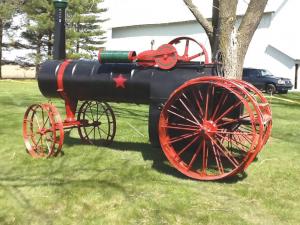He Built A “Yard Art” Steam Engine Tractor
 ✖  |
Dale Osborn bought a 125-gal. horizontal fuel tank mounted on 8-ft. legs and came up with the idea to convert it into an steam engine tractor “yard ornament”. He started collecting parts and built it in total secrecy in his farm shop.
After making many trips to the scrap pile and doing a lot of fitting, he finally got the tractor to come together. He painted it black and burgundy “because in the old days a lot of steam engines were painted those colors.” Then he made a list of all the parts that he had used to build the tractor and brought it to the show.
“Everyone was surprised to see what I had built. People really look the tractor over as they try to find all the parts on my list,” says Osborn. “The tractor doesn’t operate but some people say it looks real enough to run, which I consider a compliment. The belt pulley is free to rotate and the piston rod and the crank turn, and the tractor’s steering assembly really works. I looked at photos of several different steam engines to get the tractor proportioned correctly.
He started out by welding two 55-gal. barrels onto one end of the 125-gal. fuel tank to form the body. The dual rear steel wheels are off a manure spreader. “One set of wheels is larger than the other, which makes the tractor look wider and beefier,” says Osborn.
The front wheels are off an old Deere 999 horse drawn steel-wheeled corn planter. Most of the rest of the steering system is also off the planter, with half of an old push mower wheel serving as a pivot point for the front wheels. The belt wheel off an old Singer sewing machine serves as the steering wheel.
The tractor’s original belt pulley came off an old horsedrawn road grader, but was later changed to a wider line shaft pulley to make it look more like a steam engine pulley. The shaft is “piston-driven” by the grass catcher chute off an old riding mower. The piston leads to a tank that came off the top of the water pressure tank on Osborn’s well system. “Real steam tractors heated water to create steam and used a steam cylinder to drive the piston, which turned the belt pulley,” explains Osborn.
Contact: FARM SHOW Followup, Dale and Mary Osborn, 102 Park Circle Drive, Dickson, Tenn. 37055 (cell ph 260 413-1814; grandmaryos@aol.com).

Click here to download page story appeared in.
Click here to read entire issue
He Built A “Yard Art” Steam Engine Tractor AG WORLD Dale Osborn bought a 125-gal horizontal fuel tank mounted on 8-ft legs and came up with the idea to convert it into an steam engine tractor “yard ornament” He started collecting parts and built it in total secrecy in his farm shop After making many trips to the scrap pile and doing a lot of fitting he finally got the tractor to come together He painted it black and burgundy “because in the old days a lot of steam engines were painted those colors ” Then he made a list of all the parts that he had used to build the tractor and brought it to the show “Everyone was surprised to see what I had built People really look the tractor over as they try to find all the parts on my list ” says Osborn “The tractor doesn’t operate but some people say it looks real enough to run which I consider a compliment The belt pulley is free to rotate and the piston rod and the crank turn and the tractor’s steering assembly really works I looked at photos of several different steam engines to get the tractor proportioned correctly He started out by welding two 55-gal barrels onto one end of the 125-gal fuel tank to form the body The dual rear steel wheels are off a manure spreader “One set of wheels is larger than the other which makes the tractor look wider and beefier ” says Osborn The front wheels are off an old Deere 999 horse drawn steel-wheeled corn planter Most of the rest of the steering system is also off the planter with half of an old push mower wheel serving as a pivot point for the front wheels The belt wheel off an old Singer sewing machine serves as the steering wheel The tractor’s original belt pulley came off an old horsedrawn road grader but was later changed to a wider line shaft pulley to make it look more like a steam engine pulley The shaft is “piston-driven” by the grass catcher chute off an old riding mower The piston leads to a tank that came off the top of the water pressure tank on Osborn’s well system “Real steam tractors heated water to create steam and used a steam cylinder to drive the piston which turned the belt pulley ” explains Osborn Contact: FARM SHOW Followup Dale and Mary Osborn 102 Park Circle Drive Dickson Tenn 37055 cell ph 260 413-1814; grandmaryos@aol com







